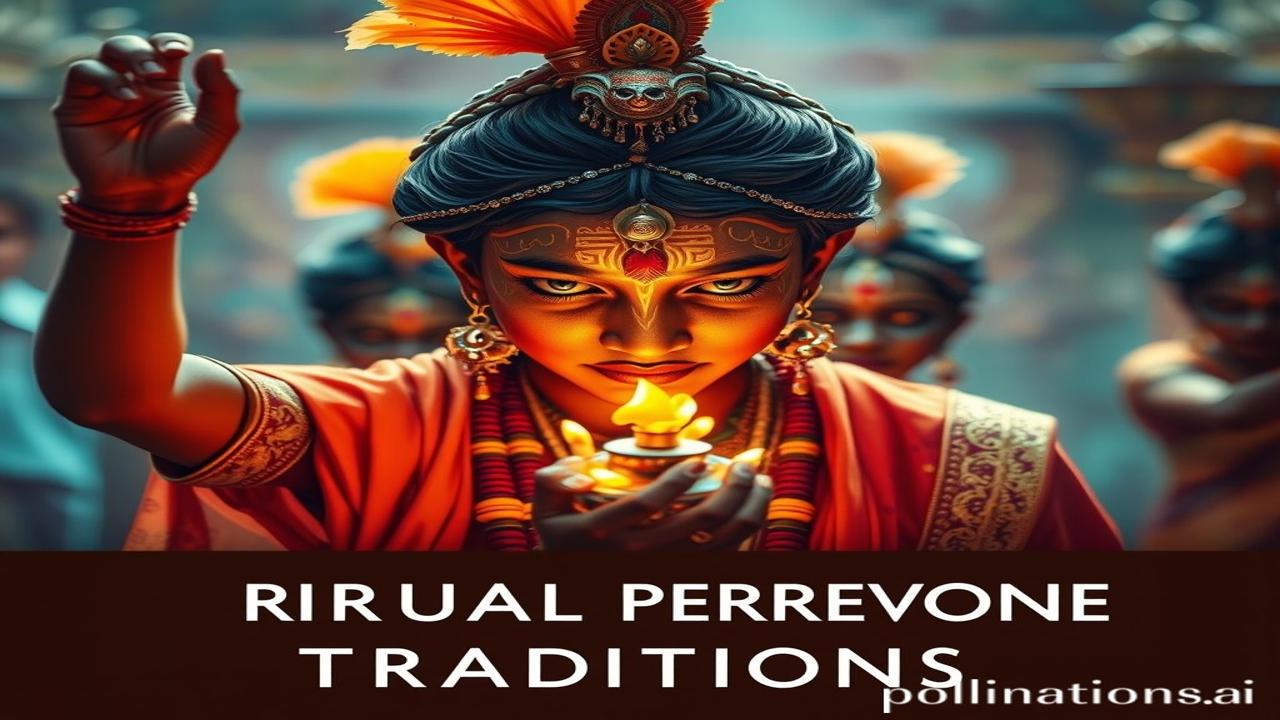Waqt Ki Dhool Mein Chhipe Rasm-o-Riwaaj: Exploring India’s Ritual Performance Traditions
Kabhi socha hai, dhol ki goonj, deepak ki lau, aur mantra ki shakti ek saath milkar kya banaate hain? Yeh hai ek jhalak us virasat ki, jo humare khoon mein basi hai – Bharat ki ritual performance traditions. Waqt ki dhool mein kuch kahaniyan chhup jaati hain, aur yeh blog unhi kahaniyon ko ubharkar laane ki ek koshish hai.
Itihaas Ki Daastaan: Understanding Ritual Performance Traditions
What exactly are ritual performance traditions? Basically, it’s where rituals meet performing arts. Think dance, music, theatre, puppetry – all used to express religious or spiritual beliefs, mark significant life events, or celebrate seasonal cycles. Yeh sirf entertainment nahi hai; yeh ek tareeka hai duniya ko samjhne ka, apne aap ko define karne ka, aur divyata se judne ka.
This goes way back! Archaeological evidence shows these practices existed in the Indus Valley Civilization (around 3300-1700 BCE). The Vedas, the ancient Hindu scriptures, are full of hymns and chants that were meant to be recited with specific rituals. Over time, these traditions evolved, absorbing influences from different cultures and religions. From the Natya Shastra, the ancient Indian treatise on performing arts, to the Bhakti movement that emphasized devotional singing and dancing, India’s ritual performance traditions have a rich and layered history.
Why is it so important? Because it’s a living link to our past. These traditions are a way of transmitting knowledge, values, and stories from one generation to the next. They reinforce social bonds, provide a sense of belonging, and offer a powerful means of expressing collective identity.
Zameeni Sach: People and Life
Imagine Ma Rukmini, a devdasi in a south Indian temple, waking before dawn. Aaj, mandir mein ek vishesh utsav hai. She wears newly woven silk sari, the colours vibrant in the early morning light. The air smells of jasmine and sandalwood. The rhythmic sounds of the nadaswaram (a South Indian wind instrument) drift from the temple courtyard. She will dance the Bharatanatyam, her body moving with grace and precision, telling ancient stories of gods and goddesses through mudras (hand gestures) and abhinaya (facial expressions).
Or picture a villager in Rajasthan, watching a traditional puppet show (Kathputli). The puppeteer, a member of a nomadic community, brings to life tales of brave Rajput warriors and wise village elders. The puppets are colourful, their movements jerky but full of life. The dholak player beats out a lively rhythm, and the audience roars with laughter and applause.
These are just glimpses into the lives of the people who kept these traditions alive. Rulers like the Cholas patronized temple dancers, artisans crafted the masks and costumes, and saints composed the devotional songs that fueled the Bhakti movement. Even farmers participated in harvest festivals, offering thanks to the gods through music and dance. Their lives were intertwined with these rituals.
Dharohar Aur Pehchan: Cultural Significance Today
Today, you can see echoes of these traditions everywhere. From the elaborate Durga Puja celebrations in West Bengal to the vibrant Garba dances during Navratri in Gujarat, ritual performance is still very much alive. You see it in the classical dance forms like Kathak and Odissi, in the folk theatre traditions like Yakshagana and Bhavai, and in the countless village festivals that take place across the country.
These traditions are an integral part of Bharatiyata. They embody our artistic heritage, our philosophical beliefs, and our collective identity. They remind us of our connection to the past, and they offer a path towards a more meaningful and fulfilling future. Even in a modern, globalized world, they provide a sense of belonging and cultural continuity.
Mazedar Tathya ya Bhram-Bhanjak: Fun Fact!
Log aksar samajhte hain ki ritual performance sirf religion se juda hua hai. Lekin asli sach yeh hai that it is also intricately woven into social and political life. Historically, these performances were used to educate people, to challenge social norms, and even to mobilize resistance against oppressive rulers. For example, in some parts of India, folk theatre was used to spread awareness about social issues like caste discrimination and poverty.
Drishya Aur Bhavnayen: Visual & Sensory Layer
Imagine standing in a bustling temple courtyard. The air is thick with incense and the scent of marigolds. The temple walls, carved with intricate sculptures, feel cool to the touch. The sounds of bells ringing, conch shells blowing, and mantras being chanted fill the air. The colours are vibrant: the bright saris of the women, the colourful offerings of flowers and fruits, the painted faces of the dancers. It’s an explosion of sensory experiences, a feast for the senses.
Antim Vichar ya Uddharan: Closing Insight
Our ritual performance traditions are more than just entertainment or spectacle. They are a reflection of our deepest beliefs, our shared history, and our collective identity. They are a living testament to the power of art to connect us to the divine, to each other, and to ourselves.
As the Upanishads say: “ॐ पूर्णमदः पूर्णमिदं पूर्णात् पूर्णमुदच्यते । पूर्णस्य पूर्णमादाय पूर्णमेवावशिष्यते ॥ ॐ शान्तिः शान्तिः शान्तिः ॥” (Om Puurnnam-Adah Puurnnam-Idam Puurnnaat-Puurnnam-Udacyate | Puurnnasya Puurnnam-Aadaaya Puurnnam-Eva-Avashissyate || Om Shaantih Shaantih Shaantih ||) – That is full, this is full; from fullness fullness proceeds. Taking fullness from fullness, fullness indeed remains. Let there be peace, peace, peace.
Let us strive to preserve and celebrate these traditions, so that they may continue to inspire and enrich our lives for generations to come.
